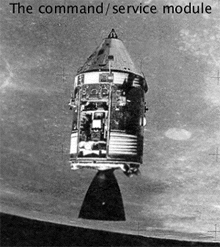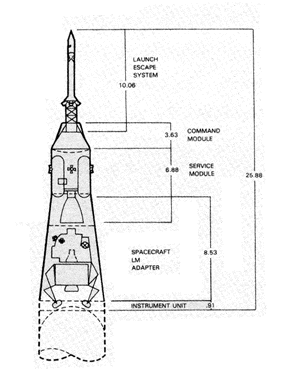Apollo shifted its focus. That goal was achieved with five months to spare, when, on July 20, 1969, Neil Armstrong and Edwin " Buzz " Aldrin touched down in the Sea of Tranquillity.
Apollo was one of the great triumphs of modern technology. Six expeditions landed on the Moon, and one - Apollo 13 - was forced to retun without landing. Before that, there had been two manned checkouts of Apollo hardware in Earth orbit and two lunar orbit missions.
| The Apollo lunar module was the first true spacecraft - designed to fly only in a vacuum, with no aerodynamic qualities whatsoever. Lauched attached to the Apollo command/service module, it separeted in lunar orbit and descended to the Moon with two astronauts inside. At the end of their stay on the surface, the lunar module's ascent stage fired its own rocket to rejoin the command/service module in lunar orbit. |  |
The teardrop-shaped Apollo command module, the living quarters for the three-person crews, had a different shape from the conical-nosed Gemini and Mercury. The attached cylindrical service modulecontained supplies as well as the Service Propulsion System engine that placed the vehicle in and out of lunar orbit.
 |
Boosting the Apollo vehicles to the Moon was the job of the giant Saturn V - the first launch vehicle large enough that it had to be assembled away from the lauch pad and transported there. A fueled Saturn V weighed more than 2.7 million kilograms at liftoff, and it stood 110.64 meters high with the Apollo vehicle on top. The vehicle had three stages - S-IC, SII, S-IVB - the last of which burned to send Apollo ou of the Earth orbit and on its way to the Moon. |
The Apollo program greatly increased the space and complexity of ground operations, both before the launch and during the misions, when ground controllers had to track two spacecraft at the same time. The lunar missions also required extensive training . Apollo astronauts logged approximately 84.000 hours - nearly ten human years - practicing for their flights. This practice included everything, from simulations of lunar gravity, to geology field trips, to flying the lunar lander training vehicle.
On January 27, 1967, just as the program was nearing readiness for its first manned flight, tragedy struck. A fire inside an Apollo command module took the lives of astronauts Virgil " Gus " Grissom, Edward White, and Roger Chaffee, who were training inside it at the time. The fire resulted in delays and modifications to the spacecraft, but by October 1968, Apollo 7 was ready to carry three astonauts into Earth orbit. There, they checked out the command/service module (both had been tested in an unmanned mode during the November 1967 Apollo 4 mission, which was also the first flight of the saturn V). By December 1968, Apollo 8 was ready to try for lunar orbit (on the Saturn V's third outing), and seven months later, Apollo 11 made the first lunar landing.
By the time the Apollo program ended in 1972, astronauts had extended the range and scope ot their lunar explorations . The final three missions were far more sophisticated than the first three, in large part because the astronauts carried a lunar rover that allowed them to roam miles from their base. Apollo 11's Armstrong and aldrin spent only two and a half hours walking on the surface. On Apollo 17, the walks on the lunar surface totaled twenty-two hours, and the astronauts spent three days " camped out " in the Moon's Taurus-Littrow valley.
After six lunar landings, the Apollo program came to a conclusion. (The Apollo 18, 19, and 20 missions had been canceled in 1970 because of budget limitations .) The ens of the program also ended the first wave of human exploration of the Moon.